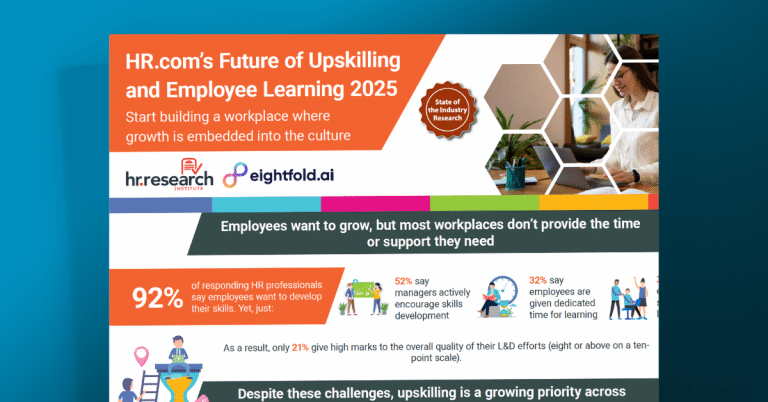
Infographic: HR.com’s future of upskilling and employee learning 2025
Infographic: HR.com’s future of upskilling and employee learning 2025
A staggering 92% of employees are eager to develop new skills, but most companies are failing to provide the support they need. This creates a critical disconnect that impacts retention, performance, and your bottom line.
This infographic, based on research from HR.com, highlights the state of corporate learning and development — and reveals why only 21% of L&D efforts earn high marks.
In this infographic, you’ll discover:
- Why only 32% of companies provide dedicated time for learning, despite overwhelming employee demand.
- The direct link between upskilling and business outcomes, including major improvements in retention and performance.
- How L&D leaders are nearly twice as likely to see substantial gains in employee engagement compared to laggards.
Employees want to grow, but most workplaces don’t provide the time or support they need. 92% of responding HR professionals say employees want to develop their skills. Yet, just:
- 52% say managers actively encourage skills development
- 32% say employees are given dedicated time for learning
- 30% report that employees are satisfied with their learning culture
As a result, only 21% give high marks to the overall quality of their L&D efforts (eight or above on a ten point scale).
Despite these challenges, upskilling is a growing priority across every level of the organization.
- 85% of responding HR professionals believe upskilling is a top 10 priority among employees.
- 83% say it’s a top priority among HR professionals
- 73% believe upskilling is a priority for senior leaders
To look ahead to the next two years:
- 56% say upskilling will become somewhat more important
- And 13% say it will become much more important
So how can organizations support employee upskilling?
First, determine what’s driving the need to upskill. The talent management needs most likely to drive upskilling are:
- Developing careers
- Retaining employees
- Boosting employee engagement
- Boosting job performance
Further, 47% say that over a fifth of jobs in their organizations will be substantially disrupted by market or technological trends over the next two years.
Second, embrace modern, flexible learning methods. Over the next two years, organizations are most likely to support employee upskilling by:
- Developing employee soft skills
- Offering customizable/personalized learning experiences
- Offering AI-based learning systems
- Using microlearning strategies
Over a quarter (28%) are upskilling employees continuously.
What L&D leaders do differently
Looking ahead to the next two years, compared to L&D laggards**, L&D leaders* are:
- Over 2X as likely to say they’ll use microlearning to support upskilling
- Over 2X as likely to say they’ll offer customizable/ personalized learning experiences
- Nearly 2X as likely to say they’ll offer AI-based learning systems
Another way is to bear down on the most effective upskilling methods. According to respondents, these are:
- 85% on-the-job learning
- 71% coaching and mentoring
- 59% blended learning
- 46% eLearning
Third, prepare your workforce for AI disruption. Organizations are considering the emerging role of artificial intelligence. To reskill employees for generative AI, employers are most likely to leverage:
- 70% internal online courses
- 61% opportunities for employees to learn by doing
Fourth, use a range of metrics to gauge the strengths and weaknesses of upskilling processes. Organizations most commonly track:
- Employee engagement
- Employee retention
- Course completion rates
However, only 1 in 4 track:
- Learner satisfaction scores
- Skills assessments
Compared to L&D laggards, L&D leaders are:
- Over 6X more likely to use learner satisfaction scores to measure the impact of employee upskilling
- Nearly 2X as likely to track skills assessments
At the end of the day better practices lead to better outcomes, including job and organizational performance. Nearly 7 in 10 agree or strongly agree upskilling results in substantial improvement in job performance.
6 in 10 agree or strongly agree upskilling results in substantial improvement in:
- Employee retention
- Employee engagement
Compared to L&D laggards, L&D leaders* are much more likely to say upskilling results in substantial improvement in:
- Employee engagement (73% vs. 44%)
- Organization performance (71% vs. 39%)
- Employee retention (70% vs. 45%)
About the survey: HR.com’s “Future of Upskilling and Employee Learning 2025” survey ran between February and May 2025. We gathered usable responses from 146 HR professionals in virtually every industry. Respondents are from all over the world, with the majority from North America, especially the United States.
L&D leaders: Respondents who rank the overall quality of their learning and development in their organization as a minimum of seven or above on a 10-point scale.
L&D laggards: those respondents who rank the overall quality of learning and development in their organization as a six or below on a 10-point scale.
You might also like...
Get the latest talent news in your inbox every month
By submitting this form, I consent to Eightfold processing my personal data in accordance with its Privacy Notice and agree to receive marketing emails from Eightfold about its products and events. I acknowledge that I can unsubscribe or update my preferences at any time.
